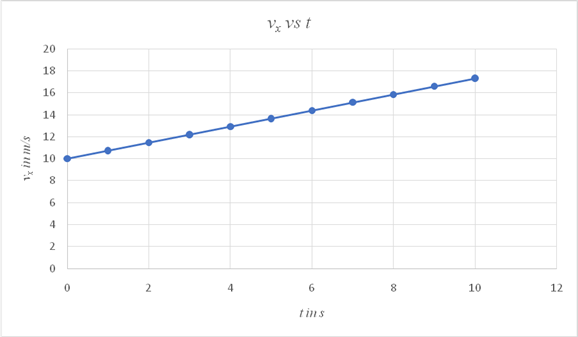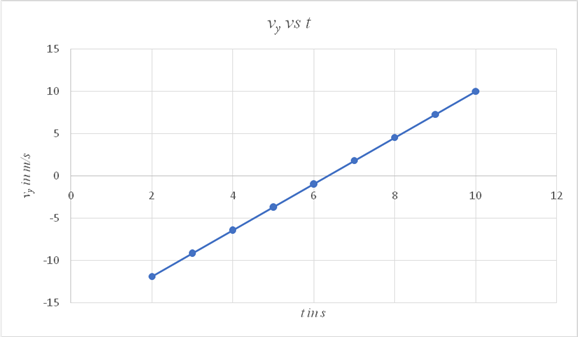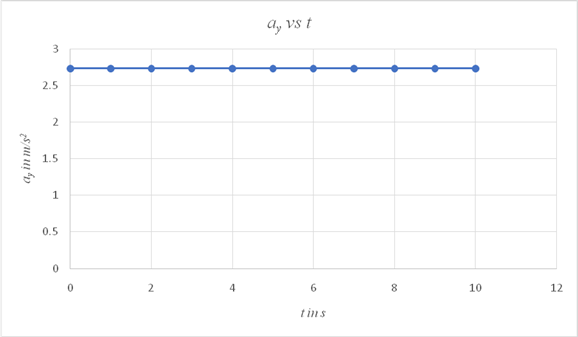
Concept explainers
(i) The x component of the velocity versus time
(ii) The y component of the velocity versus time
(iii) The y component of the acceleration versus time.
Explanation of Solution
Given info:
Magnitude of the initial velocity
Angle made by vi with x- axis
Magnitude of the final velocity
Angle made by vf with x axis
Time interval during which the velocity changes
Formula used:
The components of the velocity vectors along the x and the y directions are given by,
The change in velocity along the x and the y directions is given by,
The components of the acceleration along the x and y directions are given by,
The equation to determine the variation of
The equation to determine the variation of
Calculation:
Resolve the vectors vi and vf along the x and the y axes. This is shown in the diagram below.

The components of the velocity vector vi are directed along +x and-y axes, hence the y component is assigned a negative sign. Calculate the magnitude of the components substituting the values of the variables in the equation,
The components of the final velocity vector vf are directed along the +x and +y directions, hence the components are positive. Calculate the magnitude of the components of the vector vf using the values of the variables.
Calculate the change in velocity along the x and the y directions.
Calculate the components of the acceleration along the x and the y directions.
Using the values of vix and ax in the equation
Plot a graph showing the variation of vx with time.
| t in s | vxin m/s |
| 0 | 10 |
| 1 | 10.732 |
| 2 | 11.464 |
| 3 | 12.196 |
| 4 | 12.928 |
| 5 | 13.66 |
| 6 | 14.392 |
| 7 | 15.124 |
| 8 | 15.856 |
| 9 | 16.588 |
| 10 | 17.32 |

Using the values of viy and ay in the equation
Use the equation in a spread sheet and plot the graph showing the variation of vy with time t.
| X-Values | Y-Values |
| 0 | -17.32 |
| 1 | -14.588 |
| 2 | -11.856 |
| 3 | -9.124 |
| 4 | -6.392 |
| 5 | -3.66 |
| 6 | -0.928 |
| 7 | 1.804 |
| 8 | 4.536 |
| 9 | 7.268 |
| 10 | 10 |

The y component of the acceleration ay is independent of time, since the object's acceleration remains constant during the time interval.
Plot a graph showing the variation of ay with time t.
| t in s | ayin m/s2 |
| 0 | 2.732 |
| 1 | 2.732 |
| 2 | 2.732 |
| 3 | 2.732 |
| 4 | 2.732 |
| 5 | 2.732 |
| 6 | 2.732 |
| 7 | 2.732 |
| 8 | 2.732 |
| 9 | 2.732 |
| 10 | 2.732 |

Conclusion:
The graph showing the variation of vx with time is linear and the value increases from 10 m/s to 17.32 m/s at the end of 10 s.
The graph showing the variation of vy with time is also linear and its value increases from -17.32 m/s to reach a value of 10 m/s at the end of 10 s.
The graph showing the variation of ay with time is a straight line parallel to the time axis, showing that its value is invariant with time.
Thus all the results are consistent with an object moving with a constant acceleration during the time interval of 10s.
Want to see more full solutions like this?
Chapter 3 Solutions
FlipIt for College Physics (Algebra Version - Six Months Access)
- Consider a uniformly charged ring of radius R with total charge Q, centered at the origin inthe xy-plane. Find the electric field (as a vector) at a point on the z-axis at a distance z above thecenter of the ring. Assume the charge density is constant along the ring.arrow_forward3) If the slider block C is moving at 3m/s, determine the angular velocity of BC and the crank AB at the instant shown. (Use equation Vs Vc wx fuc, then use equation Vs VA + Ve/athen write it in terms of w and the appropriate r equate the two and solve) 0.5 m B 1 m 60° A 45° vc = 3 m/sarrow_forward3) If the slider block C is moving at 3m/s, determine the angular velocity of BC and the crank AB at the instant shown. (Use equation Vs Vc wxf, then use equation V, VA + Va/Athen write it in terms of w and the appropriate r equate the two and solve) f-3marrow_forward
- Pls help ASAParrow_forwardPls help ASAParrow_forward14. A boy is out walking his dog. From his house, he walks 30 m North, then 23 m East, then 120 cm South, then 95 m West, and finally 10 m East. Draw a diagram showing the path that the boy walked, his total displacement, and then determine the magnitude and direction of his total displacement.arrow_forward
- Pls help ASAParrow_forward12. A motorboat traveling 6 m/s, West encounters a water current travelling 3.5 m/s, South. a) Draw a vector diagram showing the resultant velocity, then determine the resultant velocity of the motorboat. b) If the width of the river is 112 m wide, then how much time does it take for the boat to travel shore to shore? c) What distance downstream does the boat reach the opposite shore?arrow_forwardLake Erie contains roughly 4.00⋅10114.00⋅1011 m3 of water. Assume the density of this water is 1000. kg/m3 and the specific heat of water is 4186 J/kg˚C. It takes 2.31x10^19 J of energy to raise the temperature of that volume of water from 12.0 °C to 25.8 ˚C. An electric power plant can produce about 1110 MW. How many years would it take to supply this amount of energy by using the 1110 MW from an electric power plant?arrow_forward
 University Physics Volume 1PhysicsISBN:9781938168277Author:William Moebs, Samuel J. Ling, Jeff SannyPublisher:OpenStax - Rice University
University Physics Volume 1PhysicsISBN:9781938168277Author:William Moebs, Samuel J. Ling, Jeff SannyPublisher:OpenStax - Rice University Principles of Physics: A Calculus-Based TextPhysicsISBN:9781133104261Author:Raymond A. Serway, John W. JewettPublisher:Cengage Learning
Principles of Physics: A Calculus-Based TextPhysicsISBN:9781133104261Author:Raymond A. Serway, John W. JewettPublisher:Cengage Learning College PhysicsPhysicsISBN:9781938168000Author:Paul Peter Urone, Roger HinrichsPublisher:OpenStax College
College PhysicsPhysicsISBN:9781938168000Author:Paul Peter Urone, Roger HinrichsPublisher:OpenStax College Physics for Scientists and Engineers: Foundations...PhysicsISBN:9781133939146Author:Katz, Debora M.Publisher:Cengage Learning
Physics for Scientists and Engineers: Foundations...PhysicsISBN:9781133939146Author:Katz, Debora M.Publisher:Cengage Learning Physics for Scientists and Engineers, Technology ...PhysicsISBN:9781305116399Author:Raymond A. Serway, John W. JewettPublisher:Cengage Learning
Physics for Scientists and Engineers, Technology ...PhysicsISBN:9781305116399Author:Raymond A. Serway, John W. JewettPublisher:Cengage Learning Glencoe Physics: Principles and Problems, Student...PhysicsISBN:9780078807213Author:Paul W. ZitzewitzPublisher:Glencoe/McGraw-Hill
Glencoe Physics: Principles and Problems, Student...PhysicsISBN:9780078807213Author:Paul W. ZitzewitzPublisher:Glencoe/McGraw-Hill





